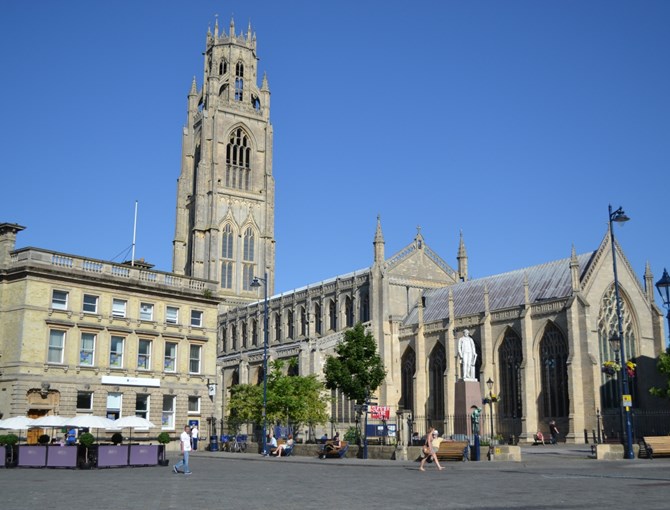

- Contact Us
- Search
-
Mayflower400 partner destinations:
Boston Guildhall
Boston Guildhall is a magnificent building that is wonderfully preserved with a wealth of original features. The Pilgrims were taken to Boston Guildhall where they were held and tried. After a month they were released.
The Guildhall was built in the 1390’s; a wealth of stories, secrets and experiences are told and shared throughout the building.
Visitors can still see the cells today where Bradford, Brewster and the Pilgrims were held and tried. You can also explore the other stories and histories across the centuries through permanent exhibitions and tales about each of the rooms. The sights, smells and sounds of the Guildhall provide a fascinating insight into the history of Boston.
Boston’s role in their story
In secret, one night in the autumn of 1607, a passionate and determined group of men, women and children met a boat on the edge of The Wash at Scotia Creek, Fishtoft, near Boston. Their plan was to escape across the North Sea to Holland and live in religious freedom away from the authority of the English church. They had travelled 60 miles from Scrooby, near Gainsborough, and were weary but hopeful for their new life across the sea.

Who were they and why did they try to escape?
They were a group of like-minded men, women and their children from Lincolnshire, Nottinghamshire and South Yorkshire who wished to have the freedom to worship as they wished rather than as the church dictated. They felt that the established church was too prescriptive, dictatorial and ‘papish’ in how it set out the order of sermons, as in the ‘Book of Common Prayer’. They were also opposed to the broader authority of the church as well as practices such as the use of wedding rings, kneeling for communion and making the sign of the cross during baptism, none of which was in the bible. Instead of wishing to try to change and ‘purify’ the church from within, as the ‘Puritans’ did, they felt compelled to separate completely from it and were called ‘Separatists’.
The group were acutely aware of how the church viewed their stance and aware of the persecution that similar separatists had been subjected to. They had been worshipping in secret in a variety of venues such as Gainsborough Old Hall and Scrooby and Babworth churches, led in worship by John Smyth and Richard Clyfton and decided escape was the only answer. Holland was a place where they knew they could practice their worship as they wished.
Betrayal
They had made arrangements with a captain to hire a ship wholly to themselves and were taken aboard during the night. They met this ship at Scotia Creek, Fishtoft near Boston. To their horror the captain of the ship had betrayed them and once on board searchers and officers ran on to the ship, seized the group and put them into open boats, rifling and ransacking both the men and women for their money, books and personal possessions which they took from them. They were carried back, upriver to the town in the boats, where they were a great spectacle with crowds flocking to see them.
Arrest
Stripped of their possessions and hope, the group were brought to Boston and the Guildhall, the home of the magistrates court and the cells, and messengers were sent to inform the Privy Council in London. Whilst the Privy Council decided upon charges the group was held. The local magistrates treated them courteously and showed them what favour they could. After a month’s imprisonment within the Guildhall the order eventually came from the council to send back the majority “from whence they came” whilst seven ringleaders were imprisoned longer and bound over to the higher court of the Lincoln Assizes.
It is not known if they ever attended the higher court but they did escape to Holland from near Immingham in North Lincolnshire the following year.
Why were the Boston Magistrates courteous?
It is known that the town of Boston would have wished to show some sympathy to the group having strong puritan, reformist and separatist leanings. Though not recorded it is quite likely the larger group were only kept under “house arrest” in the Guildhall, with the ability to move freely in the non-council areas of the building whilst only the ringleaders were confined to the cells. Why else would William Bradford, one of the group’s leaders and most influential men when they reached America, record in his book “Of Plymouth Plantation” that they were fairly treated?
You Might Also Like

Fydell House
Visitor Attraction
A Georgian house with stunning gardens.

Boston Markets
Shopping and Markets
Boston open-air markets; trading since 1545.

Maud Foster Windmill
Visitor Attraction
An English tower mill built in 1819.

Medieval Lanes
Shopping and Markets
Explore the medieval lanes of Boston.

RSBP Frampton Marsh
Park / Open Space
Enjoy the Lincolnshire side of The Wash, with close views of its stunning wildlife.

St. Botolph's Church
Visitor Attraction
The 'Puritan Path' is named after Rev. John Cotton who was preacher here.

Pilgrim Memorial
Monument / Memorial
This memorial marks the area from where the Separatists made their first attempt to escape.
Accommodation Nearby
Elms Farm Cottages, Boston

Elms Farm Cottages, Boston
Self-Catering
Luxury self-catering converted barns and stables.
Long Acres Touring Park, Boston

Long Acres Touring Park, Boston
Camping and Caravanning
Petwood Hotel

Petwood Hotel, Woodhall Spa
Hotel
A charming hotel bursting with character and history.
The White Hart Hotel, Boston

The White Hart Hotel, Boston
Hotel
A historic hotel on the River Witham.
Sign up for the latest Mayflower 400 news
You'll be the first to hear the latest Mayflower news, events, and more.
Log In
Register
Mayflower 400 Proudly Supported by our National Sponsors and Funding Partners






